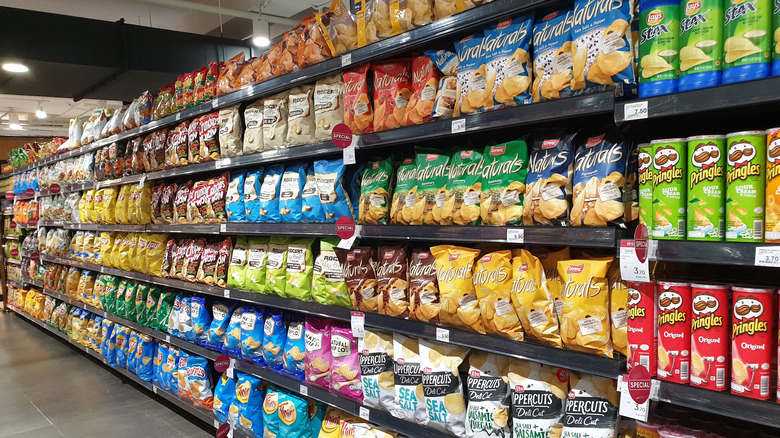New Report Finds A Shocking Amount Of Chemicals In Food Packaging
A startling new study indicates that our packaged food products may contain more potentially harmful chemicals than previously thought. According to The Guardian, a review conducted by the Food Packaging Forum found upwards of 3,000 chemicals in food packaging and other food production materials, many of which could have negative effects on human health.
The report, which was published in "Critical Reviews in Food Science and Nutrition," raised alarms about the prolific use of unvetted chemicals in food packaging and manufacturing that could pose an incalculable risk to the health of consumers.
In order to track the use of various chemicals, researchers at the Food Packaging Forum — a non-profit international organization with a goal of enabling "knowledge-based change with the aim of better protecting humans and the environment from the negative impacts of food packaging and other types of food contact articles" — compiled a database of over 12,000 chemicals previously known to be used in food manufacturing.
The comprehensive database includes chemicals found in 18 different categories of materials, including plastics, adhesives, papers, metals, and printing inks. In a recent comparison of data compiled from a number of food packaging studies and the Food Packaging Forum's database, researchers found 3,240 chemicals contained in food-related materials. Of those chemicals, a staggering 65% "were previously not known to be used in food contact materials."
Chemicals in packaging have been linked to chronic disease
"Food packaging is important for today's globalized food system, but food contact materials (FCMs) can also be a source of hazardous chemicals migrating into foodstuffs," the study reads.
According to scientists studying the potential impacts of commercial packaging on human health, the overwhelming presence of unexpected chemicals could have dire consequences. "Food packaging ... can release chemicals into food and represent a considerable source of human exposure to chemicals. As some of these chemicals are toxic, detrimental effects on health can arise," wrote the Food Packaging Forum. "The impact of chronic chemical exposure on human health, even at very low levels, is serious and has been implicated with the rising prevalence of several chronic diseases."
"The report only underlines our gross ignorance when it comes to the chemicals that people are being exposed to every day," said UC Berkeley associate professor Alastair Iles to The Guardian. "If we didn't know that there were so many chemicals in packages, what does that say about our knowledge about chemical risks?"
Certain harmful chemicals used in food manufacturing have previously been linked to a variety of ailments. Past studies have found that the group of chemicals known as phthalates, which are commonly used in food packaging, could lead to an increased risk of developing high blood pressure, cardiovascular disease, and Type-2 diabetes, particularly in men (via Nutrition Review).
Lawmakers are working to regulate certain potentially harmful chemicals
Data has shown that chronic diseases (such as hypertension, arthritis, diabetes, and other long-term medical conditions) have been consistently on the rise in recent years; And experts predict those numbers will only continue to grow (via American Action Forum). While there isn't one set cause for the rise in chronic disease, harmful chemicals found in food products and packaging may be a major contributing factor.
Just last month, McDonald's and Burger King were hit with a lawsuit due to their use of polyfluoroalkyl substances (or PFAs) — chemicals that have been found to have adverse health effects including reproductive issues, increased risk of cancer, and weakened immune systems — in fast food packaging (via New York Times). Although lawmakers have recently introduced legislation that would regulate the use of PFAs, the chemicals are currently being used in a wide variety of products (via Forbes).
While some hazardous chemicals have been barred from use in food packaging, it's impossible to determine the potential risk of the thousands of additional unregulated chemicals found throughout the food manufacturing chain (via Chemistry World). "What's most alarming is this cocktail of chemicals [and] how they're interacting with each other," said Jessica Heiges, a UC Berkeley doctoral candidate (via The Guardian). "Some of them are persisting in the environment and in our bodies as we're consuming them."


